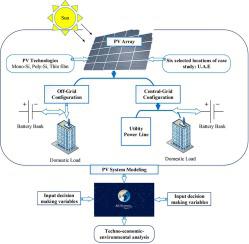Sustainable Energy Technologies and Assessments ( IF 7.1 ) Pub Date : 2020-12-15 , DOI: 10.1016/j.seta.2020.100944 Zafar Said , Aamir Mehmood , Adeel Waqas , Ahmed Amine Hachicha , Reyhaneh Loni

|
United Arab Emirates (U.A.E) is a solar-rich region aiming to achieve 44% clean energy portion in the total energy mix by 2050. Harnessing the available infinite solar renewable energy source and integrating it with the existing power infrastructure is necessary. In this context, a comprehensive technical, economic, and environmental assessment of a solar photovoltaic (PV) system for the domestic sector is presented considering U.A.E case study. The central and off-grid photovoltaic systems’ configurations are modeled to evaluate its comparative viability for six selected latitude positions of U.A.E. Further, three different photovoltaic technologies (i.e., mono-crystalline, poly-crystalline, and thin-film) are analyzed to conclude the optimum selection. Climatic conditions like incident solar radiations, humidity, air temperature, and cooling degree-days are used to conduct the feasibility assessment using the RETScreen software, where the capacity factor, the number of PV units required, base case fuel savings, net present value, payback period, and benefit-cost ratio are evaluated. Effect of reducing the battery bank size from 24 hrs to 12 hrs backup is also elaborated. The central-grid photovoltaic system configuration is concluded comparatively more viable than off-grid PV system supported by all techno-economic aspects and more environment friendly reducing 229–237 tCO2 greenhouse gas emissions during the project life.
中文翻译:

中央与离网光伏系统,基于阿拉伯联合酋长国的技术经济环境评估,是国内部门的最佳选择
United Arab Emirates (U.A.E) is a solar-rich region aiming to achieve 44% clean energy portion in the total energy mix by 2050. Harnessing the available infinite solar renewable energy source and integrating it with the existing power infrastructure is necessary. In this context, a comprehensive technical, economic, and environmental assessment of a solar photovoltaic (PV) system for the domestic sector is presented considering U.A.E case study. The central and off-grid photovoltaic systems’ configurations are modeled to evaluate its comparative viability for six selected latitude positions of U.A.E. Further, three different photovoltaic technologies (i.e., mono-crystalline, poly-crystalline, and thin-film) are analyzed to conclude the optimum selection. Climatic conditions like incident solar radiations, humidity, air temperature, and cooling degree-days are used to conduct the feasibility assessment using the RETScreen software, where the capacity factor, the number of PV units required, base case fuel savings, net present value, payback period, and benefit-cost ratio are evaluated. Effect of reducing the battery bank size from 24 hrs to 12 hrs backup is also elaborated. The central-grid photovoltaic system configuration is concluded comparatively more viable than off-grid PV system supported by all techno-economic aspects and more environment friendly reducing 229–237 tCO2项目生命期内的温室气体排放量。











































 京公网安备 11010802027423号
京公网安备 11010802027423号